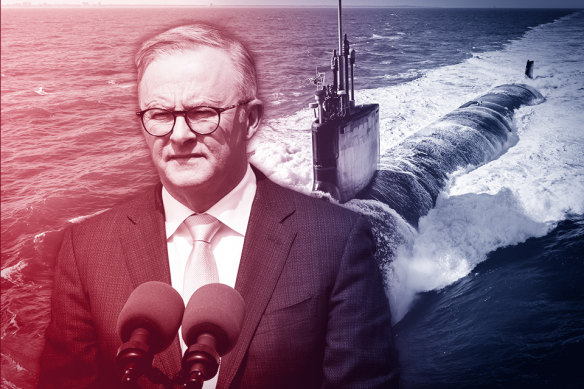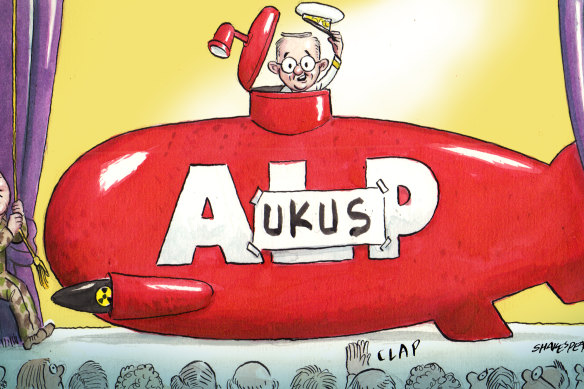Australia’s biggest AUKUS risk? Our allies’ Plan B
Save articles for later
Add articles to your saved list and come back to them any time.
The biggest enemy of AUKUS is not the resistance of ALP branches and unions but its own over-engineered grandiosity, its naive ambition.
A vote wrung from a conference doesn’t deliver the cash for what is the biggest transfer of wealth outside this country in its history. The government places the cost between $268 billion and $368 billion. That gap of $100 billion is a warning that nobody knows and bureaucrats are taking stabs.
The government places the cost between $268 billion and $368 billion.Credit: Fairfax
I recall a conversation with a journalist about the French subs before the Morrison government’s announcement of AUKUS. “That $55 billion seems very high,” I said. He assured me it wasn’t, over the life of a contract to 2050. Press a fast-forward button and that $55 billion had metastasised into a simply incomprehensible $368 billion.
Recent developments point to blowouts beyond even that budget-smashing figure. They are bound to crowd out spending on other defence platforms and on any social reforms or nation-building that a government 10 or 20 years off might want to pursue.
The first spike will come when we have to buy our way into the US sub-building program. Congressional determination to protect America’s own sub priorities first emerged in January. It is now more serious.
Three weeks ago, US Republican senators Roger Wicker and Susan Collins, with 23 Senate and House colleagues, sent a letter to President Joe Biden saying AUKUS approval must be dependent on a plan to increase US submarine production to a minimum 2.5 Virginia Class submarines per year. The US is stuck at 1.2, hard to lift because of workforce shortages.
Credit: John Shakespeare
Competition with China is producing acute pressure to lift the fleet of nuclear subs from 49 to 66, and avoid a decline to 46 by 2030. Washington is understandably reluctant to shrink the US “order of battle” by peeling off precious subs for an ally.
Turning AUKUS into a piece of alliance gospel, we’ve forgone any bargaining power and will have to settle for anything – including steep increases in cost beyond the $3 billion talked of. And three subs, not five. Or just one, for training crews. And after a long wait into the 2030s, leaving us exposed as the last of the six Collins Class are retired.
Port Kembla, Newcastle and Brisbane seem to have disguised any enthusiasm for hosting the east coast base, a key part of AUKUS. Labor people in the Illawarra, worried about local anti-nuclear feeling, have been reassured by Canberra that site selection won’t get under way until the 2030s, and take a good part of the decade, and that Port Kembla, with its coal traffic, isn’t suitable anyway. They’ve been told the navy prefers further north. But Newcastle would reject it and a Queensland site invites endless agony about the protection of the reef and resort-based tourism.
The most heroic assumption of AUKUS is that the British can deliver. Its Barrow-in-Furness shipyard struggled with the Astute class of nuclear submarines. Mark Francois MP, a member of the Commons Public Accounts Committee, called the Astute a “disaster” and said “something went horribly wrong at Barrow and has continued to go horribly wrong for years.”
It’s also attempting to build a new class of ballistic missile-firing sub called Dreadnought. The first was intended for service in 2024, then 2028 and now the “early 2030s”, according to the Ministry of Defence. BAE systems, awarded the tender for the AUKUS sub, is also seriously behind on our Hunter Class frigates selected in 2017, and still not even able to sign a contract.
The former British chief of nuclear vessels, Rear Admiral Philip Mathias, was motivated to write to the Times on March 14 to state the UK element of AUKUS was high risk. He wrote: “The performance of the submarine delivery agency has been abysmal. Astute class submarines are being delivered late by BAE systems. None of our 22 decommissioned nuclear submarines has been dismantled, which is disgraceful.”
He referred to “the substantial risk of delivery given the UK’s woeful performance and Australia’s lack of nuclear submarine expertise.”
There is no precedent for building a submarine hull in one country, installing another country’s technology and assembling it in a third which has no nuclear expertise. There is no expectation of delivery in the 2040s. The 10,000 jobs promised by our prime minister are double-counted with the 7000 promised by Boris Johnson for Barrow-in-Furness.
As the naive overreach shrinks, we could be waiting through the 2050s for the AUKUS sub, billions squeezed out of the army, surface vessels and air force to get even that far. Painful to reflect, the forgone French conventional subs might have been entering service in the 2030s, cost-effective and lethal.
The fallback position of the three AUKUS partners is easy to guess: Australia ends up hosting US and UK subs, nuclear-armed and forward-deployed here. This will, incidentally, confirm Lowy researcher Sam Roggeveen’s description of Australia becoming a US military stronghold, offering targets to China if war comes.
We would provide crews to supplement those of the UK and US vessels but forgo the independent submarine capability we enjoyed since taking our first Oberon class boat in 1963.
More shredding of sovereignty. Getting to be a habit.
Cut through the noise of federal politics with news, views and expert analysis. Subscribers can sign up to our weekly Inside Politics newsletter here.
Most Viewed in Politics
From our partners
Source: Read Full Article

